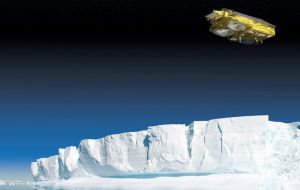MercoPress. South Atlantic News Agency
Height of Antarctica ice sheet increasing
 Pic by astrium.com
Pic by astrium.com According to findings come from the Europe’s Space Administration ESA’s ice-measuring satellite, CryoSat, over the last two years Antarctica’s ice sheet has increased in height.
In a press release ESA announced that the measurements from their 2010-2011 campaigns show the height of Antarctic ice to be an average of nine centimetres higher than the measurements obtained during the 2008-2009 campaigns.
ESA says these findings not only provide good news from the ice sheets, but also show the effectiveness of the CryoSat missions.
CryoSat is an ESA programme to monitor variations in the extent and thickness of polar ice through use of a satellite in a low Earth orbit. The information provided about the behaviour of coastal glaciers that drain thinning ice sheets will be essential to better predictions of future sea-level rise.
According to the ESA website, http://www.esa.int, CryoSat is the first scientific mission to address the thickness of land and sea ice and how this thickness is changing.
CryoSat took its measurements from a particularly harsh area of land in Antarctica, a plateau known as the “blue ice region” on the edge of the continent. This region is unique due to its vast expanses of polished blue ice.
Blue ice occurs when snow falls on a glacier, is compressed, and becomes part of a glacier that winds its way toward a body of water.
ESA chose this unique region not only to study the thickness of Antarctic ice sheets, but also to test the accuracy of CryoSat’s primary instrument known as SIRAL or SAR / Interferometric Radar Altimeter.
The abundance of ice presents a more reflective surface with which to bounce radar signals. The length of time it takes to receive these signals once they are sent determines the height of the ice.
While conducting these tests ESA found that the measurements from their 2010-2011 campaigns show the height of Antarctic ice to be an average of nine centimetres higher than the measurements from their 2008-2009 campaigns.
To corroborate the ESA findings, scientists from the Alfred Wegener Institute of Polar and Marine Research, the german scientific organization located in Bremerhaven, also took separate measurements of the blue ice region.
By analyzing each set of data the scientists were able to determine the changes in height of the ice for three different periods.
According to the ESA press release, there was a five cm drop of the height of Antarctic ice from 1991-2000 that continued until 2008. ESA does not yet have information explaining why the ice height has increased, but are encouraged at the possible upward trend.
CryoSat is operated from the European Space Operations Centre (ESOC) in Darmstadt, Germany.
Nick Tozer - Buenos Aires




Top Comments
Disclaimer & comment rules-

-

-

Read all commentsIt could also be expanding because the whole ice mass is warming... European science, oxymoron.
Mar 31st, 2012 - 11:48 pm 0The new argentine satellites (considered amongst the best built, INVAP, COCINET, CONAE... all companies sought out by the Brazilians, NASA and Europe for space cooperation), going up will provide the truth, and our better scientists clear this up. Once our rocket program is running fully in a couple of years for light loads, we will be able to launch many more satellites.
@1 you're just saying that because you read it in a mullet-book. You're not allowed to read dangerous foreign books.
Apr 01st, 2012 - 05:48 am 0The truth is that water only expands when it is cooling - unlike metals which contract when cooling...
Apr 01st, 2012 - 08:57 am 0Commenting for this story is now closed.
If you have a Facebook account, become a fan and comment on our Facebook Page!